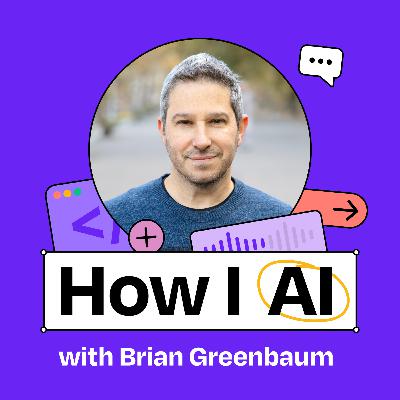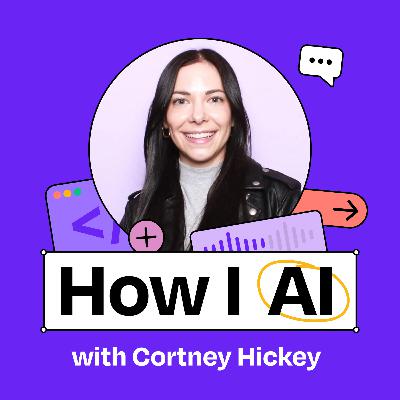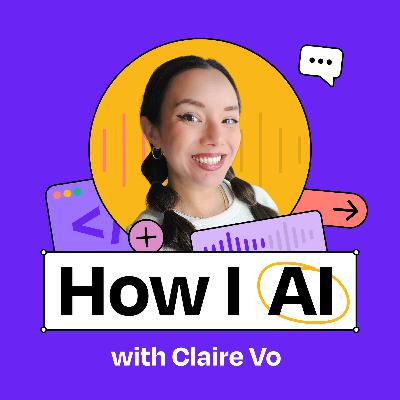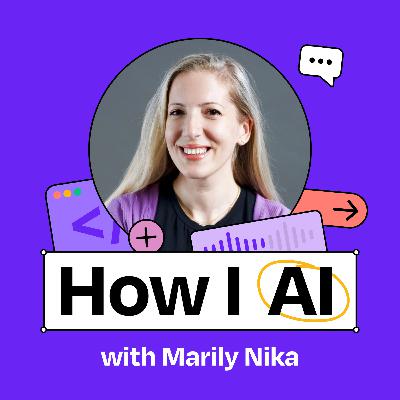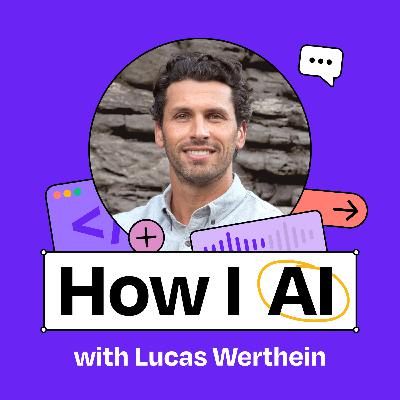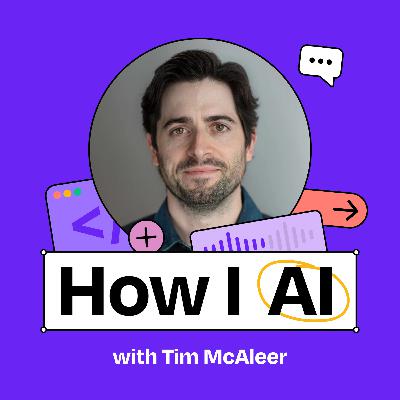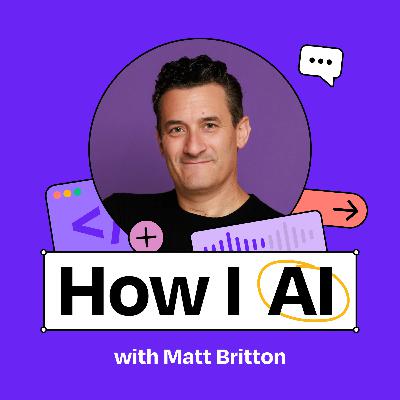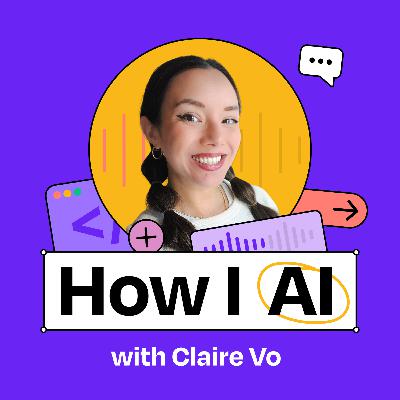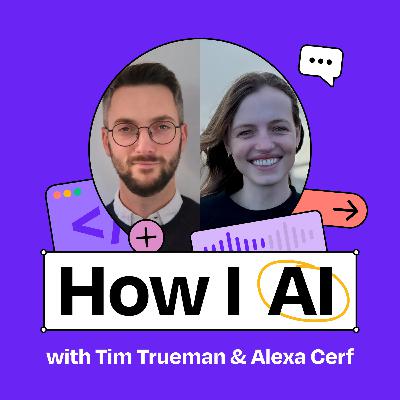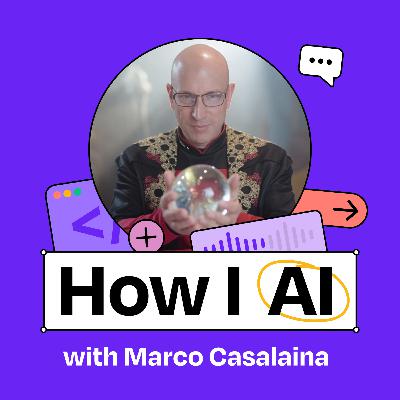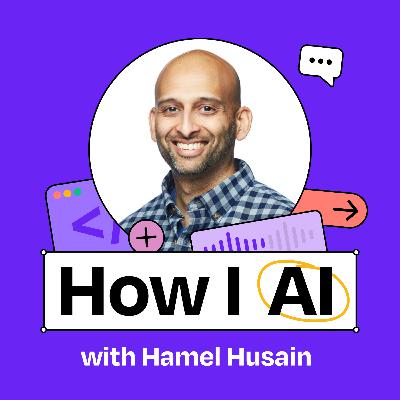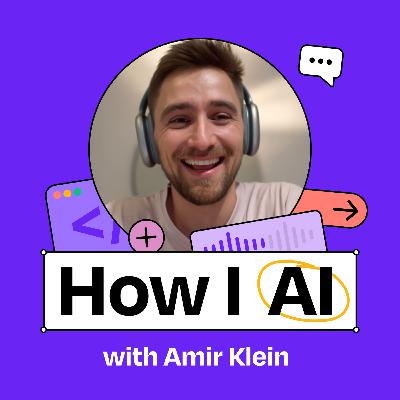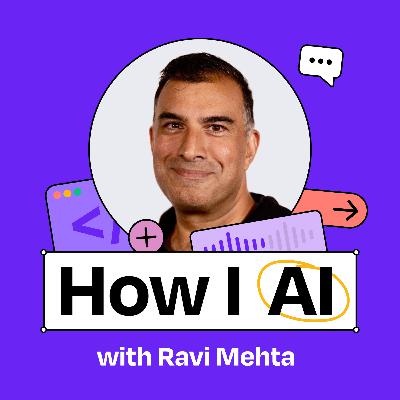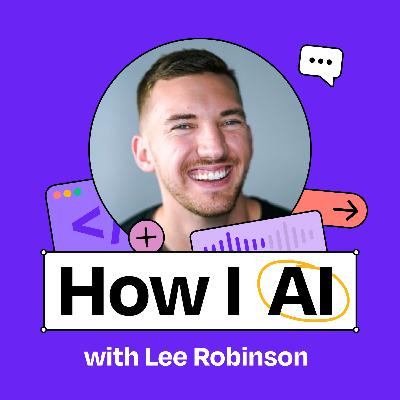Discover How I AI
How I AI

How I AI
Author: Claire Vo
Subscribed: 1,360Played: 8,481Subscribe
Share
© Claire Vo
Description
How I AI, hosted by Claire Vo, is for anyone wondering how to actually use these magical new tools to improve the quality and efficiency of their work. In each episode, guests will share a specific, practical, and impactful way they’ve learned to use AI in their work or life. Expect 30-minute episodes, live screen sharing, and tips/tricks/workflows you can copy immediately. If you want to demystify AI and learn the skills you need to thrive in this new world, this podcast is for you.
44 Episodes
Reverse
Rachel Wolan, the chief product officer at Webflow, has embraced AI not just as a product leader but as a hands-on builder. A coder since age 16, Rachel has returned to her technical roots by creating a custom AI chief-of-staff application that helps manage her executive workload. In this episode, she demonstrates how she uses personal AI software to prep for meetings, triage her calendar, manage emails, and even get brutally honest feedback about how she’s spending her time.What you’ll learn:How Rachel built a custom AI chief-of-staff application that integrates with her calendar, email, and moreWhy building personal software can be a gateway to understanding AI’s capabilities for executivesHow her AI agents help her prep for podcasts, dinners, and meetings with just-in-time informationThe technical approach to building personal AI software using markdown files, API tokens, and multiple LLM interfacesHow Rachel organized company-wide “builder days” that dramatically increased AI tool adoption across her organizationWhy she believes executives must lead by example in AI adoption to authentically drive organizational change—Brought to you by:Graphite—Your AI code review platformAtlassian for Startups —From MVP to IPO—In this episode, we cover:(00:00) Introduction to Rachel Wolan(02:26) Why Rachel started leaning into AI(06:26) Building an AI chief of staff(08:17) Prepping for the podcast(10:00) Rachel’s morning flow with her AI chief of staff(14:14) Designing a personalized interface with custom note cards(16:34) Getting “brutal truth” feedback from your AI assistant(19:34) Email triage and management workflows(23:31) Prepping for networking dinners and events(28:18) The result of building an AI chief of staff(30:09) Organizing “builder days” to drive AI adoption(35:38) Measuring the impact of AI adoption initiatives(38:00) Lightning round and final thoughts—Tools referenced:• Claude: https://claude.ai/• Claude Code: https://claude.ai/code• Cursor: https://cursor.com/• Google Calendar API: https://developers.google.com/calendar• Gmail API: https://developers.google.com/gmail• Webflow: https://webflow.com/• Figma: https://www.figma.com/• Make: https://www.make.com/• Hex: https://hex.tech/—Where to find Rachel Wolan:LinkedIn: https://www.linkedin.com/in/rachelwolan/X: https://x.com/rachelwolanWebflow: https://webflow.com—Where to find Claire Vo:ChatPRD: https://www.chatprd.ai/Website: https://clairevo.com/LinkedIn: https://www.linkedin.com/in/clairevo/X: https://x.com/clairevo—Production and marketing by https://penname.co/. For inquiries about sponsoring the podcast, email jordan@penname.co.
Brian Greenbaum is a Senior Staff Product Designer at Pendo who led a company-wide AI transformation after a personal epiphany while on paternity leave. After experiencing the power of AI coding tools firsthand, he created a structured approach to help his entire product organization adopt AI. In this episode, Brian shares his complete playbook for driving AI adoption across teams, measuring success, and navigating the organizational challenges that come with new technology adoption.What you’ll learn:The exact Slack message Brian sent while on paternity leave that kickstarted his company’s AI transformationHow to structure both synchronous and asynchronous AI learning opportunities for maximum adoptionThe two-pronged approach that dramatically increased AI tool usage across teamsWhy becoming your company’s AI champion is one of the best career moves you can make right nowHow to measure AI adoption success with sentiment surveys and clear metricsThe critical role of creating a “golden path” for AI tool usage with legal, security, and finance teams—Brought to you by:Google Gemini—Your everyday AI assistantLovable—Build apps by simply chatting with AI—In this episode, we cover:(00:00) Introduction to Brian Greenbaum(01:38) Brian’s paternity leave epiphany that sparked an AI initiative(05:00) Sending the message that launched a transformation(12:25) The two-pronged approach: synchronous and asynchronous learning(17:29) Encouraging experimentation and creative exploration(18:41) How AI enables designers to move beyond MVP thinking(22:00) Quick summary of the two-pronged approach(24:43) Measuring AI adoption(33:48) Creating a centralized AI knowledge center(35:58) Building an MCP server to demonstrate AI’s potential(44:08) Why technical understanding is crucial for non-technical roles(46:01) Final thoughts—Tools referenced:• Cursor: https://cursor.com/• Bolt.new: https://bolt.new/• Claude: https://claude.ai/• ChatGPT: https://chat.openai.com/• Midjourney: https://www.midjourney.com/• Gemini: https://gemini.google.com/—Other references:• Pendo: https://www.pendo.io/• Confluence: https://www.atlassian.com/software/confluence• Slack: https://slack.com/—Where to find Brian Greenbaum:LinkedIn: https://www.linkedin.com/in/briangreenbaum/—Where to find Claire Vo:ChatPRD: https://www.chatprd.ai/Website: https://clairevo.com/LinkedIn: https://www.linkedin.com/in/clairevo/X: https://x.com/clairevo—Production and marketing by https://penname.co/. For inquiries about sponsoring the podcast, email jordan@penname.co.
Cortney Hickey is the executive assistant to the CEO at Zapier, where she’s leveraging AI to transform traditional EA responsibilities into scalable, organization-wide systems. In this episode, she demonstrates how she’s built AI workflows that automate meeting preparation, reinforce company culture through automated feedback, and democratize strategic knowledge across the organization. Her approach shows how EAs can use AI not to replace their roles but to elevate them—working on higher-impact initiatives while creating systems that benefit the entire company.What you’ll learn:How to build an automated meeting prep system that researches participants, checks CRM data, and delivers actionable insights before important meetingsA framework for creating AI-powered culture reinforcement through automated meeting feedback aligned with company values and operating principlesHow to develop an AI-powered document review system that helps teams align with executive expectations before formal reviewsA strategy for creating a centralized knowledge base that makes company strategy accessible and interactive for all employeesWhy “progress over perfection” is the key mindset for building effective AI workflows that evolve over timeHow EAs can use AI automation to work themselves out of repetitive tasks and into higher-impact strategic roles—Brought to you by:WorkOS—Make your app enterprise-ready todayBrex—The intelligent finance platform built for founders—In this episode, we cover:(00:00) Introduction to Cortney(02:48) Overview of meeting prep automation with Zapier Agents(04:43) How the meeting prep agent works(10:21) An example of the meeting prep agent in practice(12:16) Creating a culture reinforcement system through meeting feedback(15:45) EAs’ unique position to leverage these tools(18:12) Building an automated meeting coach(24:03) Developing an executive document review system(33:15) Creating a centralized strategy companion in NotebookLM(36:18) How AI is transforming the EA role, not replacing it(40:00) Lightning round and final thoughts—Tools referenced:• Zapier: https://zapier.com/• Zapier Agents: https://zapier.com/agents• Todoist: https://todoist.com/• Slack: https://slack.com/• HubSpot: https://www.hubspot.com/• ChatGPT: https://chat.openai.com/• Google NotebookLM: https://notebooklm.google/—Where to find Cortney Hickey:LinkedIn: https://www.linkedin.com/in/cortneyhickey/—Where to find Claire Vo:ChatPRD: https://www.chatprd.ai/Website: https://clairevo.com/LinkedIn: https://www.linkedin.com/in/clairevo/X: https://x.com/clairevo—Production and marketing by https://penname.co/. For inquiries about sponsoring the podcast, email jordan@penname.co.
Michal Peled is a Technical Operations Engineer at HoneyBook who specializes in building internal tools and automations that eliminate friction for teams. In this episode, Michal demonstrates three practical AI use cases: using ChatGPT’s agent mode to automate LinkedIn recruiting, transforming customer research into interactive AI personas, and creating a custom calendar solution for a very San Francisco–specific problem—avoiding expensive parking during Giants games.What you’ll learn:How to use ChatGPT agent mode to automate LinkedIn recruiting and find high-quality candidates that manual searches missedThe step-by-step process for turning static customer research into interactive AI personas that product and marketing teams can actually useWhy NotebookLM excels at creating prompts from source material with proper citationsHow to structure agent-mode prompts to create effective “little helpers” that follow your exact workflowA practical framework for improving your prompts when AI tools aren’t giving you the results you wantHow internal tools teams can drive massive impact by focusing on eliminating friction in everyday workflows—Brought to you by:Brex—The intelligent finance platform built for foundersGoogle Gemini—Your everyday AI assistant—In this episode, we cover:(00:00) Introduction to Michal and ChatGPT agent mode(02:10) Using agent mode for LinkedIn recruiting automation(05:14) Creating effective prompts for agent mode(10:50) Demo of agent mode searching LinkedIn profiles(16:29) Results and team reception of the recruiting automation(19:53) The outcome of implementing on Michal’s team(23:50) Creating custom GPT personas from customer research(28:43) Using NotebookLM to transform research into persona prompts(35:00) Adding guardrails to custom GPT personas(37:20) Demo of interacting with custom-persona GPTs(41:02) Creating a calendar automation for parking during baseball games(48:15) Lightning round and final thoughts—Tools referenced:• ChatGPT: https://chat.openai.com/• NotebookLM: https://notebooklm.google.com/• Claude: https://claude.ai/—Other references:• Google Calendar: https://calendar.google.com/• HoneyBook: https://www.honeybook.com/• LinkedIn: https://www.linkedin.com/—Where to find Michal Peled:LinkedIn: https://www.linkedin.com/in/michalpeled/—Where to find Claire Vo:ChatPRD: https://www.chatprd.ai/Website: https://clairevo.com/LinkedIn: https://www.linkedin.com/in/clairevo/X: https://x.com/clairevo—Production and marketing by https://penname.co/. For inquiries about sponsoring the podcast, email jordan@penname.co.
I put three cutting-edge AI models to the test in a head-to-head design competition. Using the exact same prompt, I challenged Google’s Gemini 3, Anthropic’s Opus 4.5, and OpenAI’s Codex 5.1 to redesign my blog page, evaluating them on visual design quality, user experience improvements, and SEO optimization capabilities. One model produced a beautiful, polished, production-ready redesign. One was fine. And one completely whiffed. If you’re trying to figure out where each model fits in your workflow—design, planning, back-end, or something else—this episode will save you a lot of trial and error.What you’ll learn:How each AI model approaches the same design challenge differentlyWhy planning capabilities dramatically impact design qualityThe specific visual and functional improvements each model madeWhich model excels at front-end design versus back-end functionalityHow to strategically choose the right AI model for different parts of your workflowThe importance of model-switching based on specific use cases—Blog design: https://www.chatprd.ai/blog—Brought to you by:Lovable—Build apps by simply chatting with AI—Where to find Claire Vo:ChatPRD: https://www.chatprd.ai/Website: https://clairevo.com/LinkedIn: https://www.linkedin.com/in/clairevo/X: https://x.com/clairevo—In this episode, we cover:(00:00) Introduction to the AI design challenge(01:25) The question: Which model is the better designer?(03:08) The prompt used for all three models(04:10) Gemini 3 Pro’s approach and results(06:00) Opus 4.5’s approach and results(10:54) Codex 5.1’s approach and disappointing results(14:51) Comparing the three designs side by side(16:03) Analyzing the change logs and SEO improvements from each model(22:43) Final verdict(23:00) Conclusion and next steps—Tools referenced:• Gemini 3 Pro: https://deepmind.google/models/gemini/pro/• Anthropic Opus 4.5: https://www.anthropic.com/news/claude-opus-4-5• OpenAI Codex 5.1: https://platform.openai.com/docs/models/gpt-5.1-codex• Cursor: https://cursor.com/—Production and marketing by https://penname.co/. For inquiries about sponsoring the podcast, email jordan@penname.co.
Marily Nika, AI Product Lead at Google and founder of the AI Product Academy, demonstrates how product managers can leverage AI tools to dramatically accelerate their workflow. Using a smart-fridge concept as an example, Marily walks us through the exact workflow she uses to build products faster: doing user research with Reddit debates, generating PRDs with custom GPTs, prototyping with v0, and even creating stakeholder-ready video mockups using VEO and Sora. She shows how “tool hopping” between specialized AI applications creates a powerful workflow that transforms traditional PM processes and enables more compelling product storytelling.What you’ll learn:How to use Perplexity’s “discussions and opinions” filter to mine Reddit for user insights and create pro/con agent debates that reveal product-market fit requirementsA workflow for transforming market research into comprehensive PRDs using custom GPTs that maintain your personal voice and styleTechniques for turning PRDs into interactive prototypes using v0.dev that make your product vision tangible for stakeholdersHow to create persuasive product videos using Flow and Sora that communicate your vision more effectively than traditional presentationsWhy “tool hopping” between specialized AI applications creates a more powerful workflow than using a single toolHow to use NotebookLM as an interactive judge for product demos and pitch competitions—Brought to you by:WorkOS—Make your app enterprise-ready todayMiro—The AI Innovation Workspace where teams discover, plan, and ship breakthrough products—Where to find Marily Nika:LinkedIn: https://www.linkedin.com/in/marilynika/Website: https://www.marilynika.me/Substack: https://marily.substack.com/AI Product Management Bootcamp & Certification by AI Product Academy: https://bit.ly/4p8tn2r—Where to find Claire Vo:ChatPRD: https://www.chatprd.ai/Website: https://clairevo.com/LinkedIn: https://www.linkedin.com/in/clairevo/X: https://x.com/clairevo—In this episode, we cover:(00:00) Introduction to Marily Nika(02:54) Smart-fridge use case inspiration(06:15) Using Perplexity to mine Reddit for user research(11:19) Creating a comprehensive PRD with ChatGPT(13:40) Building an interactive prototype with v0(16:20) Using prototypes as stakeholder influence tools in product reviews(21:30) Generating product videos with Flow and Sora(30:17) The complete 20-minute product workflow, from research to video(32:06) Using NotebookLM as an AI judge for product demo days(37:38) What to do when AI tools aren’t giving you what you want—Tools referenced:• Perplexity: https://www.perplexity.ai/• ChatGPT: https://chat.openai.com/• v0.dev: https://v0.dev/• Flow (Google Labs): https://labs.google/flow/about• Sora: https://openai.com/sora• NotebookLM: https://notebooklm.google/—Other references:• AI Product Management Bootcamp: https://maven.com/lenny/ai-product-management• Lenny’s List on Maven: https://maven.com/lenny—Production and marketing by https://penname.co/. For inquiries about sponsoring the podcast, email jordan@penname.co.
Lucas Werthein, the COO and co-founder of Cactus, shares how he built a personalized AI wellness coach using ChatGPT to optimize his athletic performance while managing past injuries. After multiple surgeries on his knees, shoulder, and foot, Lucas created a system that synthesizes data from medical imaging, blood tests, wearable devices, and nutrition plans to provide personalized recommendations. His AI coach helps him balance competitive tennis, weightlifting, and running a company while maintaining his goal of “feeling 25 in a 40-year-old body.” Lucas demonstrates how this approach transforms siloed health information into actionable insights that protect joints, optimize recovery, and extend peak performance.What you’ll learn:How to configure a ChatGPT with multiple data types, including MRIs, x-rays, blood tests, and wearable metrics, to create a comprehensive health profileA framework for setting clear performance boundaries that prioritize joint protection, energy optimization, and injury preventionTechniques for using AI to balance nutrition around special events like social dinners while maintaining performance goalsHow to use images and videos to get AI feedback on physical symptoms and injury recovery timelinesA method for validating and contextualizing medical advice by having AI synthesize information from multiple health-care providersWhy creating clear rules and anti-prompts helps AI deliver practical, evidence-based recommendations instead of trendy supplements or extreme protocols—Copy Lucas’s Health Coach Prompt: https://www.lennysnewsletter.com/p/how-to-create-your-own-ai-performance-coach—Brought to you by:WorkOS—Make your app enterprise-ready todayGoogle Gemini—Your everyday AI assistant—Where to find Lucas Werthein:Website: https://cactus.is/—Where to find Claire Vo:ChatPRD: https://www.chatprd.ai/Website: https://clairevo.com/LinkedIn: https://www.linkedin.com/in/clairevo/X: https://x.com/clairevo—In this episode, we cover:(00:00) Introduction to Lucas’s athletic background and injury history(04:55) The challenge of synthesizing siloed health data(06:11) Building a GPT to optimize performance and recovery(09:57) Demonstrating the data types integrated into the AI coach(13:54) Configuring the GPT with clear performance goals and boundaries(16:31) Setting realistic expectations for the AI coach(17:50) Creating nutrition, training, and recovery frameworks(21:47) Establishing hard boundaries and anti-prompts(24:25) Example: Managing nutrition around special events(27:30) Accessibility and affordability of on-demand coaching(28:24) Practical examples and real-life scenarios(29:31) Using AI for injury management and recovery planning(34:19) Validating expert opinions and translating medical advice(37:25) Vision for the future of AI in personal health coaching(43:27) Other AI workflows: synthetic clients and AI co-founders(48:48) Final thoughts on AI reliability and evolution—Tool referenced:• ChatGPT: https://chat.openai.com/—Other references:• InBody scan: https://inbodyusa.com/• Whoop: https://www.whoop.com/—Production and marketing by https://penname.co/. For inquiries about sponsoring the podcast, email jordan@penname.co.
In today’s pre-Thanksgiving episode, I walk you through how I vibe coded my very own “Thanksgiving party hub” using Lovable—and how I transformed it from AI-generated slop into something warm, personal, and genuinely useful. I show you exactly how I upleveled the typography, visuals, and structure using Google Fonts and Midjourney style references, and then I share one of my favorite real-life AI hacks: how to turn any messy online recipe into a clean, step-by-step, kid-friendly version that’s actually usable while you’re cooking. This is a cozy, practical walkthrough of my real design process—the little tricks I use to make AI-built apps feel handcrafted instead of generic.What you’ll learn:How to build a fully functional Thanksgiving party hub in Lovable—guests, dishes, recipes, and photosHow I uplevel AI-generated designs using Google Fonts and TailwindHow to use Midjourney style references to create custom images that match your aestheticHow to add custom features to vibe-coded apps, like dietary preferences and allergen tagsHow to iterate on layouts inside Lovable using screenshots and small, targeted promptsHow I use ChatGPT to restructure recipes so the measurements are embedded directly in each stepHow to make recipes kid-friendly and easier to follow using a simple formatting prompt—Brought to you by:WorkOS—Make your app enterprise-ready today—Where to find Claire Vo:ChatPRD: https://www.chatprd.ai/Website: https://clairevo.com/LinkedIn: https://www.linkedin.com/in/clairevo/X: https://x.com/clairevo—In this episode, we cover:(00:00) Introduction to the Thanksgiving party hub concept(02:20) Starting a project in Lovable and initial design assessment(04:59) Upleveling typography with Google Font combinations(08:36) Creating custom header images with Midjourney(11:39) Adjusting aspect ratios for Midjourney images(14:22) Fixing design issues incrementally(18:52) Adding dietary-restriction functionality(23:36) AI recipe reformatting for easier cooking(26:02) Thoughts on ChatGPT 5.1(30:51) Final implementation and recipe sharing—Tools referenced:• Lovable: https://lovable.dev/• Midjourney: https://www.midjourney.com/• Google Fonts: https://fonts.google.com/• ChatGPT: https://chat.openai.com/• Canva Font Combinations: https://www.canva.com/font-combinations/—Other references:• Polenta and Sausage Stuffing Recipe: https://www.epicurious.com/recipes/food/views/polenta-and-sausage-stuffing-233030 • Runaway Pancakes (kid-friendly recipe site): https://runawaypancakes.com/—Production and marketing by https://penname.co/. For inquiries about sponsoring the podcast, email jordan@penname.co.
Tim McAleer is a producer at Ken Burns’s Florentine Films who is responsible for the technology and processes that power their documentary production. Rather than using AI to generate creative content, Tim has built custom AI-powered tools that automate the most tedious parts of documentary filmmaking: organizing and extracting metadata from tens of thousands of archival images, videos, and audio files. In this episode, Tim demonstrates how he’s transformed post-production workflows using AI to make vast archives of historical material actually usable and searchable.What you’ll learn:How Tim built an AI system that automatically extracts and embeds metadata into archival images and footageThe custom iOS app he created that transforms chaotic archival research into structured, searchable dataHow AI-powered OCR is making previously illegible historical documents accessibleWhy Tim uses different AI models for different tasks (Claude for coding, OpenAI for images, Whisper for audio)How vector embeddings enable semantic search across massive documentary archivesA practical approach to building custom AI tools that solve specific workflow problemsWhy AI is most valuable for automating tedious tasks rather than replacing creative work—Brought to you by:Brex—The intelligent finance platform built for founders—Where to find Tim McAleer:Website: https://timmcaleer.com/LinkedIn: https://www.linkedin.com/in/timmcaleer/—Where to find Claire Vo:ChatPRD: https://www.chatprd.ai/Website: https://clairevo.com/LinkedIn: https://www.linkedin.com/in/clairevo/X: https://x.com/clairevo—In this episode, we cover:(00:00) Introduction to Tim McAleer(02:23) The scale of media management in documentary filmmaking(04:16) Building a database system for archival assets(06:02) Early experiments with AI image description(08:59) Adding metadata extraction to improve accuracy(12:54) Scaling from single scripts to a complete REST API(15:16) Processing video with frame sampling and audio transcription(19:10) Implementing vector embeddings for semantic search(21:22) How AI frees up researchers to focus on content discovery(24:21) Demo of “Flip Flop” iOS app for field research(29:33) How structured file naming improves workflow efficiency(32:20) “OCR Party” app for processing historical documents(34:56) The versatility of different app form factors for specific workflows(40:34) Learning approach and parallels with creative software(42:00) Perspectives on AI in the film industry(44:05) Prompting techniques and troubleshooting AI workflows—Tools referenced:• Claude: https://claude.ai/• ChatGPT: https://chat.openai.com/• OpenAI Vision API: https://platform.openai.com/docs/guides/vision• Whisper: https://github.com/openai/whisper• Cursor: https://cursor.sh/• Superwhisper: https://superwhisper.com/• CLIP: https://github.com/openai/CLIP• Gemini: https://deepmind.google/technologies/gemini/—Other references:• Florentine Films: https://www.florentinefilms.com/• Ken Burns: https://www.pbs.org/kenburns/• Muhammad Ali documentary: https://www.pbs.org/kenburns/muhammad-ali/• The American Revolution series: https://www.pbs.org/kenburns/the-american-revolution/• Archival Producers Alliance: https://www.archivalproducersalliance.com/genai-guidelines• Exif metadata standard: https://en.wikipedia.org/wiki/Exif• Library of Congress: https://www.loc.gov/—Production and marketing by https://penname.co/. For inquiries about sponsoring the podcast, email jordan@penname.co.
Matt Britton is the founder and CEO of Suzy, a consumer insights platform that has raised over $100 million in venture capital and works with top brands like Coca-Cola, Google, Procter & Gamble, and Nike. Matt is also the bestselling author of YouthNation, a blueprint for understanding the seismic shifts shaping our future economy, and Generation AI, which explores how Gen Alpha and artificial intelligence will transform business, culture, and society. In this episode, Matt demonstrates how he built a comprehensive AI workflow using Zapier that transforms customer call transcripts into a wealth of actionable intelligence. Despite not being a coder, Matt created a system that automatically generates call summaries, sentiment analysis, coaching feedback, follow-up emails, SEO-optimized blog posts, and more—all from a single customer conversation.What you’ll learn:How to build a trigger-based workflow that automatically scrapes and processes customer call transcripts from platforms like GongA systematic approach to quantifying customer sentiment on a 1-10 scale that has proven highly predictive of churn and upsell opportunitiesHow to create an automated coaching system that provides personalized feedback to sales reps after every customer interactionA workflow for extracting keywords from customer conversations to inform Google ad campaigns without manual interventionTechniques for automatically generating privacy-compliant blog content from customer calls that drives organic traffic and paid search performanceWhy CEOs and executives need to build AI skills firsthand rather than delegating implementation to engineering teamsHow to use Google Sheets as structured databases for AI lookups and enrichment within automated workflows—Brought to you by:Brex—The intelligent finance platform built for foundersZapier—The most connected AI orchestration platform—Where to find Matt Britton:LinkedIn: linkedin.com/in/mattbbrittonInstagram: https://www.instagram.com/mattbrittonnyc/Company: https://www.suzy.com/—Where to find Claire Vo:ChatPRD: https://www.chatprd.ai/Website: https://clairevo.com/LinkedIn: https://www.linkedin.com/in/clairevo/X: https://x.com/clairevo—In this episode, we cover:(00:00) Introduction to Matt Britton(02:36) Why Zapier became the backbone of Matt’s AI automations(04:17) Identifying your core business problem(09:02) How Matt built the initial trigger automation with Browse AI(13:42) The value of CEOs getting hands-on with building(14:00) Scraping and processing call transcripts(20:14) Using LLMs to generate call summaries and sentiment scores(23:25) Creating a Slack channel for real-time call insights(26:17) Extracting keywords for Google Ads campaigns(28:35) Building an AI coach for sales and customer success teams(29:48) Creating a follow-up email writer for post-call communication(35:25) Generating redacted blog content from customer conversations(37:51) How this approach changes team building and hiring priorities(40:19) Matt’s prompting techniques and final thoughts—Tools referenced:• Zapier: https://zapier.com/• Gong: https://www.gong.io/• Browse AI: https://www.browse.ai/• ChatGPT: https://chat.openai.com/—Other references:• Qualtrics: https://www.qualtrics.com/• SurveyMonkey: https://www.surveymonkey.com/• Slack: https://slack.com/• Google Sheets: https://www.google.com/sheets/about/—Production and marketing by https://penname.co/. For inquiries about sponsoring the podcast, email jordan@penname.co.
This episode is for complete beginners. I walk you through how to build your very first coding project using AI tools—even if you’ve never written a line of code. Together, we’ll create a personal project hub that automatically generates documentation and lets you build interactive prototypes. I’ll show you the process step by step—from setting up a repository, to creating AI agents that help with specific tasks, to deploying a functional web app locally.What you’ll learn:How to set up a simple Next.js application from scratch using Cursor’s AI agent capabilitiesMy workflow for creating AI agents that generate consistent documentation (like PRDs in Markdown format)How to build and display clickable prototypes without worrying about complex backend functionalityThe basics of using GitHub to track changes and manage your code repository as a non-technical personWhy starting with a personal project hub is the best way to ease into AI-assisted codingMy favorite practical tips for iterating on designs and functionality using AI tools—without needing deep technical expertise—Brought to you by:ChatPRD—An AI copilot for PMs and their teams—In this episode, we cover:(00:00) Introduction(05:11) Starting with a requirements document in ChatPRD(08:22) Attempting to use v0 for initial prototyping(15:02) Pivoting to Cursor for initial prototyping(20:20) Running the app locally and reviewing the initial version(24:07) Setting up GitHub for version control(27:09) Creating an AI agent for writing PRDs(31:04) Using the agent to create a sample PRD(35:00) Building a prototype based on the PRD(37:00) Testing and improving the prototype(40:00) Adding documentation and improving the design(43:20) Recap of the complete workflow—Tools referenced:• Cursor: https://cursor.com/• ChatPRD: https://www.chatprd.ai/• v0: https://v0.dev/• GitHub Desktop: https://desktop.github.com/• Next.js: https://nextjs.org/• Tailwind CSS: https://tailwindcss.com/—Other references:• Lovable: https://lovable.ai/• Bolt: https://bolt.new/• Claude Code: https://www.claude.com/product/claude-code• Markdown: https://www.markdownguide.org/• GitHub: https://github.com/—Production and marketing by https://penname.co/. For inquiries about sponsoring the podcast, email jordan@penname.co.
Tim Trueman and Alexa Cerf from Faire’s data team demonstrate how AI tools are revolutionizing data analysis workflows. They show how data teams, product managers, and engineers can use tools like Cursor, ChatGPT, and custom agents to investigate business metrics, analyze experiment results, and extract insights from user surveys—all while dramatically reducing the time and technical expertise required.What you’ll learn:1. How to use AI to investigate sudden drops in business metrics by searching documentation and codebases2. Techniques for creating a semantic layer that helps AI understand your business data3. How to build end-to-end analytics workflows using Cursor and Model Context Protocols (MCPs)4. Ways to automate experiment analysis and create standardized reports5. How AI can help design and analyze customer surveys6. Strategies for creating executive-ready documents from raw data analysis7. Why every team member should have access to code repositories—not just engineers—Brought to you by:Zapier—The most connected AI orchestration platformBrex—The intelligent finance platform built for founders—Where to find Tim Trueman:LinkedIn: https://www.linkedin.com/in/tim-trueman-99788592/—Where to find Alexa Cerf:LinkedIn: https://www.linkedin.com/in/alexandra-cerf/—Where to find Claire Vo:ChatPRD: https://www.chatprd.ai/Website: https://clairevo.com/LinkedIn: https://www.linkedin.com/in/clairevo/X: https://x.com/clairevo—In this episode, we cover:(00:00) Introduction to Tim and Alexa from Faire(02:53) The challenge of analyzing product quality and usage(04:14) Breaking down what analytics actually involves beyond data manipulation(05:46) Demo: Investigating a conversion rate drop using enterprise AI search(09:05) Using ChatGPT Deep Research to analyze code changes(12:40) Leveraging Cursor as the ultimate context engine for code analysis(18:55) Analyzing a new product feature’s performance with Cursor(26:27) How semantic layers make AI tools more effective for data analysis(30:00) Using Model Context Protocols (MCPs) to connect AI with data tools(34:17) Creating visualizations and dashboards with Mode integration(37:04) Generating structured analysis documents with Notion integration(44:39) Building custom agents to automate experiment result documentation(53:10) Designing and analyzing customer surveys(59:40) Lightning round and final thoughts—Tools referenced:• Cursor: https://cursor.com/• ChatGPT: https://chat.openai.com/• Notion: https://www.notion.so/• Snowflake: https://www.snowflake.com/• Mode: https://mode.com• Qualtrics: https://www.qualtrics.com/• GitHub: https://github.com/—Other references:• Model Context Protocol (MCP): https://www.anthropic.com/news/model-context-protocol• Faire Careers: https://www.faire.com/careers—Production and marketing by https://penname.co/. For inquiries about sponsoring the podcast, email jordan@penname.co.
In this impromptu Halloween special, Marco Casalaina (VP of Products for Core AI at Microsoft) demonstrates how he uses GitHub Spark to quickly build a mobile app that generates kid-friendly fortunes for trick-or-treaters.—Where to find Marco Casalaina:LinkedIn: https://www.linkedin.com/in/marcocasalaina/X: https://x.com/amrcn_werewolf?lang=en—Where to find Claire Vo:ChatPRD: https://www.chatprd.ai/Website: https://clairevo.com/LinkedIn: https://www.linkedin.com/in/clairevo/X: https://x.com/clairevo—In this episode, we cover:(00:00) Intro(00:40) Marco’s Halloween fortune teller tradition(02:54) Using GitHub Spark to create a fortune teller app(04:32) Using Spec Kit for scoping out complex feature specs(06:53) Making fortunes more concrete and kid-friendly(10:20) Closing thoughts—Tools referenced:• GitHub Spark: https://github.com/features/spark• SpecKit: https://github.com/github/spec-kit• GitHub Copilot: https://github.com/features/copilot• Cursor: https://cursor.com/• Claude Code: https://www.claude.com/product/claude-code—Production and marketing by https://penname.co/. For inquiries about sponsoring the podcast, email jordan@penname.co.
Dennis Yang is the Principal Product Manager for Generative AI at Chime, where he’s pioneered AI workflows that meaningfully increase productivity. While most people use Cursor as a coding tool, Dennis has turned it into a comprehensive product-management system that automates PRD creation, documentation management, ticket creation, status reporting, and even comment responses—without writing code. In this episode, he shares his end-to-end workflow and how non-technical professionals can leverage AI-powered IDEs.What you’ll learn:Why Cursor is the perfect hub for product management (even if you don’t code)How to use MCPs (Model Context Protocols) to push content between Cursor, Confluence, and NotionThe workflow for creating PRDs in Cursor and automatically responding to commentsHow to automate Jira ticket creation directly from your PRDsA system for generating comprehensive status reports without manual workHow to prototype AI products in minutes using Cursor as a “super MVP” environmentWhy source-controlled markdown files might replace traditional SaaS tools—Brought to you by:Zapier—The most connected AI orchestration platformBrex—The intelligent finance platform built for founders—Where to find Dennis Yang:Twitter/X: https://twitter.com/sinnedLinkedIn: https://www.linkedin.com/in/dennisyang/Chime: https://www.chime.com/—Where to find Claire Vo:ChatPRD: https://www.chatprd.ai/Website: https://clairevo.com/LinkedIn: https://www.linkedin.com/in/clairevo/X: https://x.com/clairevo—In this episode, we cover:(00:00) Introduction to Dennis Yang(03:00) Why Cursor is ideal for product management workflows(04:53) Setting up Cursor for non-coding use cases with markdown preview(09:35) Creating PRDs in Cursor and using source control for documentation(10:33) Using MCPs to publish content to Confluence and Notion(11:38) Bridging the gap between engineering and product(17:00) Reading and responding to document comments with AI assistance(21:37) Creating comprehensive Jira tickets directly from PRDs(25:51) Generating automated status reports from Jira data(30:23) Building a morning briefing system with ChatGPT(35:03) Generating personal morning briefings using ChatGPT(40:04) The “super MVP” approach to AI product development(46:37) Lightning round and final thoughts—Tools referenced:• Cursor: https://cursor.com/• Confluence: https://www.atlassian.com/software/confluence• Notion: https://www.notion.so/• Jira: https://www.atlassian.com/software/jira• ChatGPT: https://chat.openai.com/• Claude: https://claude.ai/• Git: https://git-scm.com/—Other references:• News API: https://newsapi.org/• Semrush: https://www.semrush.com/—Production and marketing by https://penname.co/. For inquiries about sponsoring the podcast, email jordan@penname.co.
Today I dive into Anthropic’s latest feature that lets anyone create reusable workflows for Claude—no coding required. I break down exactly what Claude Skills are, how to build them from scratch, and how to use them inside Claude Code and Cursor to automate recurring AI tasks like generating PRDs, writing changelog summaries, and turning demo notes into follow-up emails.What you’ll learn:What Claude Skills are and how they differ from Claude Projects and custom GPTsHow to structure a Skill (metadata, instructions, and linked files)Why defining workflows in natural language beats rigid automation toolsHow to create Claude Skills using Claude Code and CursorHow to validate your skills with Python scripts and folder referencesHow to upload and use Claude Skills inside Claude’s web or desktop appPractical examples: turning changelogs into newsletters, demo notes into emails, and more—Brought to you by:ChatPRD—An AI copilot for PMs and their teams—Where to find Claire Vo:ChatPRD: https://www.chatprd.ai/Website: https://clairevo.com/LinkedIn: https://www.linkedin.com/in/clairevo/X: https://x.com/clairevo—In this episode, we cover:(00:00) Introduction(01:39) What are Claude Skills and how do they work?(08:30) The structure of Claude Skills files(11:00) Demo: Creating Skills using Claude’s built-in skill creator(16:08) A more efficient workflow: Creating Skills with Cursor(17:42) Using Python validation scripts(18:37) Testing Skills with Claude Code(20:52) Creating a changelog-to-newsletter Skill(22:16) Creating a demo-to-follow-up-email Skill(23:45) Uploading Skills to the Claude web interface(26:04) Conclusion and summary—Tools referenced:• Claude: https://claude.ai/• Claude Code: https://claude.ai/code• Cursor: https://cursor.sh/—Other references:• Equipping agents for the real world with Agent Skills: https://www.anthropic.com/engineering/equipping-agents-for-the-real-world-with-agent-skills• Anthropic Skills Documentation: https://docs.claude.com/en/docs/claude-code/skills?utm_source=chatgpt.com• Claude Projects:https://claude.ai/projects—Production and marketing by https://penname.co/. For inquiries about sponsoring the podcast, email jordan@penname.co.
Priya Badger, a product manager at Yelp, shares her innovative approach to designing AI-powered products by starting with example conversations rather than traditional wireframes or PRDs. In this episode, she demonstrates how she uses Claude and Magic Patterns to prototype Yelp’s AI assistant features—from exploring conversation flows to designing user interfaces. What you’ll learn:1. How to use example conversations as your first “wireframe” when designing conversational AI products2. A step-by-step workflow for using Claude to generate and refine sample conversations that guide your AI product development3. Techniques for creating interactive prototypes with Claude Artifacts that use real LLM responses without complex API integrations4. How to use Magic Patterns’ Inspiration mode to rapidly explore multiple UI variations for your AI features5. Why starting with conversations and working backward to system prompts creates more natural AI interactions6. How to apply these AI prototyping techniques to personal projects to build your AI product management skills—Brought to you by:GoFundMe Giving Funds—One account. Zero hassle.Persona—Trusted identity verification for any use case—Where to find Priya Badger:LinkedIn: https://www.linkedin.com/in/priyamathewprofile/Substack: https://almostmagic.substack.com/—Where to find Claire Vo:ChatPRD: https://www.chatprd.ai/Website: https://clairevo.com/LinkedIn: https://www.linkedin.com/in/clairevo/X: https://x.com/clairevo—In this episode, we cover:(00:00) Introduction to Priya(02:54) The unique challenges of managing AI-powered products(04:33) Using example conversations as a starting point for design(05:53) Demo: Prompting Claude to generate sample conversations(09:10) Prototyping advice(09:53) Testing with multiple example images and scenarios(15:03) Refining conversations based on qualitative assessment(15:59) Demo: Creating interactive prototypes with Claude Artifacts(21:22) Using Magic Patterns to design the user interface(25:30) Exploring multiple design variations with Inspiration mode(31:02) Quick summary(33:35) How to apply these AI prototyping techniques to personal projects(38:57) Final thoughts—Tools referenced:• Claude: https://claude.ai/• Magic Patterns: https://magicpatterns.com/• Lovable: https://lovable.ai/• Figma: https://www.figma.com/• ChatGPT: https://chat.openai.com/—Other references:• How to build prototypes that actually look like your product | Colin Matthews (product leader, AI prototyping instructor at Maven): https://www.lennysnewsletter.com/p/how-to-build-prototypes-that-actually—Production and marketing by https://penname.co/. For inquiries about sponsoring the podcast, email jordan@penname.co.
Hamel Husain, an AI consultant and educator, shares his systematic approach to improving AI product quality through error analysis, evaluation frameworks, and prompt engineering. In this episode, he demonstrates how product teams can move beyond “vibe checking” their AI systems to implement data-driven quality improvement processes that identify and fix the most common errors. Using real examples from client work with Nurture Boss (an AI assistant for property managers), Hamel walks through practical techniques that product managers can implement immediately to dramatically improve their AI products.What you’ll learn:1. A step-by-step error analysis framework that helps identify and categorize the most common AI failures in your product2. How to create custom annotation systems that make reviewing AI conversations faster and more insightful3. Why binary evaluations (pass/fail) are more useful than arbitrary quality scores for measuring AI performance4. Techniques for validating your LLM judges to ensure they align with human quality expectations5. A practical approach to prioritizing fixes based on frequency counting rather than intuition6. Why looking at real user conversations (not just ideal test cases) is critical for understanding AI product failures7. How to build a comprehensive quality system that spans from manual review to automated evaluation—Brought to you by:GoFundMe Giving Funds—One account. Zero hassle: https://gofundme.com/howiaiPersona—Trusted identity verification for any use case: https://withpersona.com/lp/howiai—Where to find Hamel Husain:Website: https://hamel.dev/Twitter: https://twitter.com/HamelHusainCourse: https://maven.com/parlance-labs/evalsGitHub: https://github.com/hamelsmu—Where to find Claire Vo:ChatPRD: https://www.chatprd.ai/Website: https://clairevo.com/LinkedIn: https://www.linkedin.com/in/clairevo/X: https://x.com/clairevo—In this episode, we cover:(00:00) Introduction to Hamel Husain(03:05) The fundamentals: why data analysis is critical for AI products(06:58) Understanding traces and examining real user interactions(13:35) Error analysis: a systematic approach to finding AI failures(17:40) Creating custom annotation systems for faster review(22:23) The impact of this process(25:15) Different types of evaluations(29:30) LLM-as-a-Judge(33:58) Improving prompts and system instructions(38:15) Analyzing agent workflows(40:38) Hamel’s personal AI tools and workflows(48:02) Lighting round and final thoughts—Tools referenced:• Claude: https://claude.ai/• Braintrust: https://www.braintrust.dev/docs/start• Phoenix: https://phoenix.arize.com/• AI Studio: https://aistudio.google.com/• ChatGPT: https://chat.openai.com/• Gemini: https://gemini.google.com/—Other references:• Who Validates the Validators? Aligning LLM-Assisted Evaluation of LLM Outputs with Human Preferences: https://dl.acm.org/doi/10.1145/3654777.3676450• Nurture Boss: https://nurtureboss.io• Rechat: https://rechat.com/• Your AI Product Needs Evals: https://hamel.dev/blog/posts/evals/• A Field Guide to Rapidly Improving AI Products: https://hamel.dev/blog/posts/field-guide/• Creating a LLM-as-a-Judge That Drives Business Results: https://hamel.dev/blog/posts/llm-judge/• Lenny’s List on Maven: https://maven.com/lenny—Production and marketing by https://penname.co/. For inquiries about sponsoring the podcast, email jordan@penname.co.
Amir Klein is a product manager at Monday.com, leading their AI agents initiative. Despite taking two months of paternity leave, he ranked #4 out of 90 PMs in AI tool usage at his company. In this episode, Amir reveals how he’s become “highly dependent and maybe incapable” of doing his job without AI, showing his custom GPT workflows that help him manage context switching, analyze customer feedback, improve his writing, and prepare for product interviews.What you’ll learn:How to create project-specific “second brains” in Claude and ChatGPT that hold context for you across multiple workstreamsA step-by-step process for using Claude to build a Reddit scraper that gathers thousands of customer conversations, without coding expertiseHow to analyze large datasets of customer feedback using AI to identify patterns, priorities, and key discussion pointsA workflow for creating custom GPTs that help you improve specific skills based on manager feedbackTechniques for using GPT voice mode to conduct realistic mock interviews that provide candid feedback on your responsesWhy “everything is text” should be your mindset when feeding information into AI tools, from PDFs to slide decksHow to use AI to respond quickly to stakeholder requests even when you’re context switching between multiple projects—Brought to you by:GoFundMe Giving Funds—One account. Zero hassle.Miro—A collaborative visual platform where your best work comes to life—Where to find Amir Klein:LinkedIn: https://www.linkedin.com/in/amir-klein-9b8444189/—Where to find Claire Vo:ChatPRD: https://www.chatprd.ai/Website: https://clairevo.com/LinkedIn: https://www.linkedin.com/in/clairevo/X: https://x.com/clairevo—In this episode, we cover:(00:00) Introduction to Amir(03:11) Using custom GPT project folders as “second brains”(06:24) Building a Reddit scraper with Claude’s help(11:02) Analyzing 34,000 rows of Reddit conversations(14:06) How to build effective custom GPT knowledge bases(18:04) Creating a custom writing coach from Lenny’s Newsletter(21:53) Using AI for professional development and feedback(24:08) Preparing for product interviews with GPT voice mode(31:49) Additional use cases for voice mode(33:04) Recap of Amir’s AI workflows(35:43) Lightning round and final thoughts—Tools referenced:• Claude: https://claude.ai/• ChatGPT: https://chat.openai.com/• Reddit API: https://www.reddit.com/dev/api/• Python: https://www.python.org/• Slack: https://slack.com/—Other references:• Wes Kao: https://weskao.com/• Become a better communicator: Specific frameworks to improve your clarity, influence, and impact | Wes Kao (coach, entrepreneur, advisor): https://www.lennysnewsletter.com/p/become-a-better-communicator-specific• On Writing Well by William Zinsser: https://www.amazon.com/Writing-Well-Classic-Guide-Nonfiction/dp/0060891548• The Elements of Style by Strunk and White: https://www.amazon.com/Elements-Style-Fourth-William-Strunk/dp/020530902X• Exponent YouTube channel: https://www.youtube.com/c/ExponentTV• monday.com: https://monday.com/—Production and marketing by https://penname.co/. For inquiries about sponsoring the podcast, email jordan@penname.co.
Ravi Mehta, now a product advisor, has built and scaled products used by millions. His past roles include Chief Product Officer at Tinder, Entrepreneur in Residence at Reforge, and senior product leadership positions at Facebook, TripAdvisor, and Xbox. In this episode, Ravi demonstrates his data-driven approach to AI prototyping that produces dramatically better results than traditional "vibe prototyping." He also shares his structured framework for generating professional-quality images in Midjourney that look like they were shot by a professional photographer.What you’ll learn:Why most product managers and designers are “vibe prototyping” with AI and getting mediocre resultsHow to use JSON data models instead of design systems as the foundation for better AI prototypesA simple three-part framework for structuring Midjourney prompts to get professional-quality photosHow to use Claude and Unsplash’s MCP server to generate realistic data and images for your prototypesWhy real data (not Lorem Ipsum) is critical for getting meaningful feedback from stakeholdersThe film stock “cheat code” that instantly elevates your AI-generated photos—Brought to you by:Google Gemini—Your everyday AI assistantPersona—Trusted identity verification for any use case—Where to find Ravi Mehta:Website: https://www.ravi-mehta.com/Reforge: https://www.reforge.com/profiles/ravi-mehtaLinkedIn: https://www.linkedin.com/in/ravimehta/X: https://x.com/ravi_mehta—Where to find Claire Vo:ChatPRD: https://www.chatprd.ai/Website: https://clairevo.com/LinkedIn: https://www.linkedin.com/in/clairevo/X: https://x.com/clairevo—In this episode, we cover:(00:00) Introduction to Ravi and data-driven prototyping(02:31) The problem with “vibe prototyping” in product development(04:18) Spec-driven prototyping vs. data-driven prototyping(05:27) Demo: Spec-driven approach to prototyping(08:26) Limitations of the basic AI prototype approach(11:24) The data-driven prototyping approach explained(12:08) Demo: Data-driven prototyping(17:45) Creating a prototype with the generated JSON data(23:33) Comparing the quality difference between approaches(26:44) Modifying the prototype(28:53) Benefits of this approach(34:40) Structured Midjourney prompting(36:20) The subject-setting-style framework for better image prompts(44:27) Using camera metadata to refine your results(48:54) Lightning round and final thoughts—Tools referenced:• Claude: https://claude.ai/• Reforge Build: https://www.reforge.com/build• Midjourney: https://www.midjourney.com/• Unsplash MCP: https://github.com/okooo5km/unsplash-mcp-server-go?utm_source=chatgpt.com—Other references:• Reforge AI Strategy Course: https://www.reforge.com/courses/ai-strategy—Production and marketing by https://penname.co/. For inquiries about sponsoring the podcast, email jordan@penname.co.
Lee Robinson is the head of AI education at Cursor, where he teaches people how to build software with AI. Previously, he helped build Vercel and Next.js as an early employee. In this episode, he demonstrates how Cursor's AI-powered code editor bridges the gap between beginners and experienced developers through automated error fixing, parallel task execution, and writing assistance. Lee walks through practical examples of using Cursor's agent to improve code quality, manage technical debt, and even enhance your writing by eliminating common AI patterns and clichés.What you'll learn:1. How to use Cursor's AI agent to automatically detect and fix linting errors without needing to understand complex terminal commands2. A workflow for running parallel coding tasks by focusing on your main work while the agent handles secondary features in the background3. Why setting up typed languages, linters, formatters, and tests creates guardrails that help AI tools generate better code4. How to create custom commands for code reviews that automatically check for security issues, test coverage, and other quality concerns5. A technique for improving your writing by creating a custom prompt with banned words and phrases that eliminates AI-generated patterns6. Strategies for managing context in AI conversations to maintain high-quality responses and avoid degradation7. Why looking at code—even when you don't fully understand it—is one of the best ways to learn programming—Brought to you by:Google Gemini—Your everyday AI assistantPersona—Trusted identity verification for any use case—Where to find Lee Robinson:Twitter/X: https://twitter.com/leeerobWebsite: https://leerob.com—Where to find Claire Vo:ChatPRD: https://www.chatprd.ai/Website: https://clairevo.com/LinkedIn: https://www.linkedin.com/in/clairevo/X: https://x.com/clairevo—In this episode, we cover:(00:00) Introduction to Lee(02:04) Understanding Cursor's three-panel interface(06:27) The importance of typed languages, linters, and tests(11:28) Demo: Using the agent to automatically fix lint errors(15:17) Running parallel coding tasks with the agent(18:50) Setting up custom rules(23:24) Understanding the different AI models(24:48) Micro-slicing agent chats for better success(27:22) Tips for effective agent usage(29:00) Using AI to improve your writing(35:47) Lightning round and final thoughts—Tools referenced:• Cursor: https://cursor.com/• ChatGPT: https://chat.openai.com/• JavaScript: https://developer.mozilla.org/en-US/docs/Web/JavaScript• Python: https://www.python.org/• TypeScript: https://www.typescriptlang.org/• Git: https://git-scm.com/—Other references:• Linting: https://en.wikipedia.org/wiki/Lint_(software)—Production and marketing by https://penname.co/. For inquiries about sponsoring the podcast, email jordan@penname.co.



